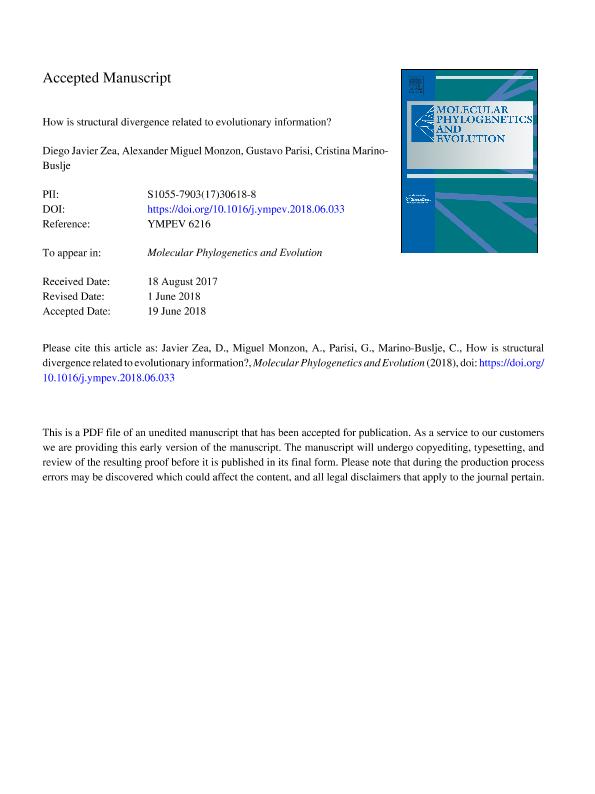Mostrar el registro sencillo del ítem
dc.contributor.author
Zea, Diego Javier

dc.contributor.author
Monzón, Alexander

dc.contributor.author
Parisi, Gustavo Daniel

dc.contributor.author
Marino, Cristina Ester

dc.date.available
2019-12-02T20:07:52Z
dc.date.issued
2018-10
dc.identifier.citation
Zea, Diego Javier; Monzón, Alexander; Parisi, Gustavo Daniel; Marino, Cristina Ester; How is structural divergence related to evolutionary information?; Academic Press Inc Elsevier Science; Molecular Phylogenetics and Evolution; 127; 10-2018; 859-866
dc.identifier.issn
1055-7903
dc.identifier.uri
http://hdl.handle.net/11336/91112
dc.description.abstract
The analysis of evolutionary information in a protein family, such as conservation and covariation, is often linked to its structural information. Multiple sequence alignments of distant homologous sequences are used to measure evolutionary variables. Although high structural differences between proteins can be expected in such divergent alignments, most works linking evolutionary and structural information use a single structure ignoring the structural variability within protein families. The goal of this work is to elucidate the relevance of structural divergence when sequence-based measures are integrated with structural information. We found that inter-residue contacts and solvent accessibility undergo large variations in protein families. Our results show that high covariation scores tend to reveal residue contacts that are conserved in the family, instead of protein or conformer specific contacts. We also found that residue accessible surface area shows a high variability between structures of the same family. As a consequence, the mean relative solvent accessibility of multiple structures correlates better with the conservation pattern than the relative solvent accessibility of a single structure. We conclude that the use of comprehensive structural information allows a more accurate interpretation of the information computed from sequence alignments. Therefore, considering structural divergence would lead to a better understanding of protein function, dynamics, and evolution.
dc.format
application/pdf
dc.language.iso
eng
dc.publisher
Academic Press Inc Elsevier Science

dc.rights
info:eu-repo/semantics/openAccess
dc.rights.uri
https://creativecommons.org/licenses/by-nc-nd/2.5/ar/
dc.subject
COEVOLUTION
dc.subject
CONFORMATIONAL DIVERSITY
dc.subject
CONSERVATION
dc.subject
SOLVENT ACCESSIBILITY
dc.subject
STRUCTURAL DIVERGENCE
dc.subject.classification
Otros Tópicos Biológicos

dc.subject.classification
Ciencias Biológicas

dc.subject.classification
CIENCIAS NATURALES Y EXACTAS

dc.title
How is structural divergence related to evolutionary information?
dc.type
info:eu-repo/semantics/article
dc.type
info:ar-repo/semantics/artículo
dc.type
info:eu-repo/semantics/publishedVersion
dc.date.updated
2019-10-22T17:43:12Z
dc.journal.volume
127
dc.journal.pagination
859-866
dc.journal.pais
Estados Unidos

dc.description.fil
Fil: Zea, Diego Javier. Consejo Nacional de Investigaciones Científicas y Técnicas. Oficina de Coordinación Administrativa Parque Centenario. Instituto de Investigaciones Bioquímicas de Buenos Aires. Fundación Instituto Leloir. Instituto de Investigaciones Bioquímicas de Buenos Aires; Argentina
dc.description.fil
Fil: Monzón, Alexander. Consejo Nacional de Investigaciones Científicas y Técnicas. Oficina de Coordinación Administrativa Parque Centenario. Instituto de Investigaciones Bioquímicas de Buenos Aires. Fundación Instituto Leloir. Instituto de Investigaciones Bioquímicas de Buenos Aires; Argentina
dc.description.fil
Fil: Parisi, Gustavo Daniel. Consejo Nacional de Investigaciones Científicas y Técnicas. Oficina de Coordinación Administrativa Parque Centenario. Instituto de Investigaciones Bioquímicas de Buenos Aires. Fundación Instituto Leloir. Instituto de Investigaciones Bioquímicas de Buenos Aires; Argentina
dc.description.fil
Fil: Marino, Cristina Ester. Consejo Nacional de Investigaciones Científicas y Técnicas. Oficina de Coordinación Administrativa Parque Centenario. Instituto de Investigaciones Bioquímicas de Buenos Aires. Fundación Instituto Leloir. Instituto de Investigaciones Bioquímicas de Buenos Aires; Argentina
dc.journal.title
Molecular Phylogenetics and Evolution

dc.relation.alternativeid
info:eu-repo/semantics/altIdentifier/doi/http://dx.doi.org/10.1016/j.ympev.2018.06.033
dc.relation.alternativeid
info:eu-repo/semantics/altIdentifier/url/https://www.sciencedirect.com/science/article/pii/S1055790317306188
Archivos asociados
